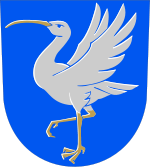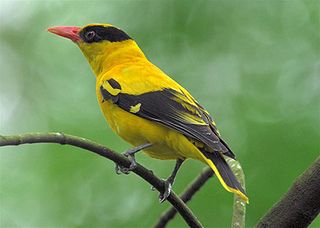
Orioles are colourful Old World passerine birds in the genus Oriolus, the type genus of the corvoidean family Oriolidae. They are not closely related to the New World orioles, which are icterids that belong to the superfamily Passeroidea.

Pica is a genus of seven species of birds in the family Corvidae in both the New World and the Old. It is one of several corvid genera whose members are known as magpies.

Junglefowl are the only four living species of bird from the genus Gallus in the bird order Galliformes, and occur in parts of South and Southeast Asia. One of the species in this genus, the red junglefowl, is of historical importance as the direct ancestor of the domestic chicken, although the grey junglefowl, Sri Lankan junglefowl and green junglefowl are likely to have also been involved. The Sri Lankan junglefowl is the national bird of Sri Lanka. They diverged from their common ancestor about 4–6 million years ago. Although originating in Asia, remains of junglefowl bones have also been found in regions of Chile, which date back to 1321–1407 CE, providing evidence of possible Polynesian migration through the Pacific Ocean.
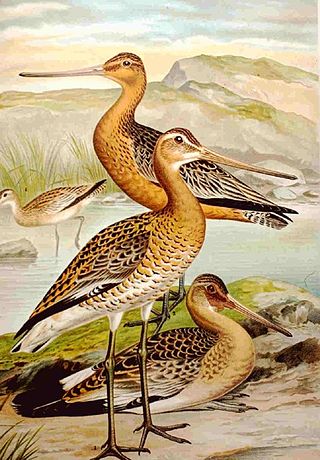
The godwits are a group of four large, long-billed, long-legged and strongly migratory waders of the bird genus Limosa. Their long bills allow them to probe deeply in the sand for aquatic worms and molluscs. In their winter range, they flock together where food is plentiful. They frequent tidal shorelines, breeding in northern climates in summer and migrating south in winter. A female bar-tailed godwit made a flight of 29,000 km (18,000 mi), flying 11,680 kilometres (7,260 mi) of it without stopping. In 2020 a male bar-tailed godwit flew about 12,200 kilometres (7,600 mi) non-stop in its migration from Alaska to New Zealand, previously a record for avian non-stop flight. In October 2022, a 5 month old, male bar-tailed godwit was tracked from Alaska to Tasmania, a trip that took 11 days, and recorded a non-stop flight of 8,400 miles (13,500 km).
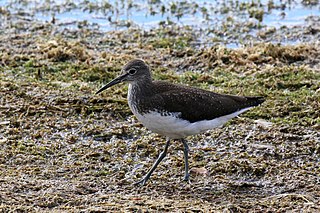
The green sandpiper is a small wader (shorebird) of the Old World.

The Eurasian curlew or common curlew is a very large wader in the family Scolopacidae. It is one of the most widespread of the curlews, breeding across temperate Europe and Asia. In Europe, this species is often referred to just as the "curlew", and in Scotland known as the "whaup" in Scots.

The Eurasian or common whimbrel, also known as the white-rumped whimbrel in North America, is a wader in the large family Scolopacidae. It is one of the most widespread of the curlews, breeding across much of subarctic Asia and Europe as far south as Scotland. This species and the Hudsonian whimbrel have recently been split, although some taxonomic authorities still consider them to be conspecific.
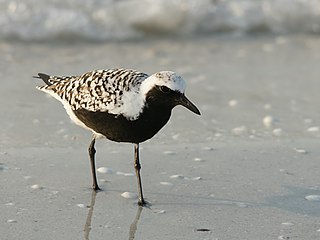
The grey plover or black-bellied plover is a large plover breeding in Arctic regions. It is a long-distance migrant, with a nearly worldwide coastal distribution when not breeding.

The marbled godwit is a large migratory shorebird in the family Scolopacidae. On average, it is the largest of the four species of godwit.

The red-necked phalarope, also known as the northern phalarope and hyperborean phalarope, is a small wader. This phalarope breeds in the Arctic regions of North America and Eurasia. It is migratory, and, unusually for a wader, winters at sea on tropical oceans.

The red phalarope or grey phalarope is a small wader. This phalarope breeds in the Arctic regions of North America and Eurasia. It is migratory, and, unusually for a wader, migrates mainly on oceanic routes, wintering at sea on tropical oceans.

The yellow-billed oxpecker is a passerine bird in the family Buphagidae. It was previously placed in the starling and myna family, Sturnidae.

The bristle-thighed curlew is a medium-sized shorebird that breeds in Alaska and winters on tropical Pacific islands.

The Far Eastern curlew is a large shorebird most similar in appearance to the long-billed curlew, but slightly larger. It is mostly brown in color, differentiated from other curlews by its plain, unpatterned brown underwing. It is not only the largest curlew but probably the world's largest sandpiper, at 60–66 cm (24–26 in) in length and 110 cm (43 in) across the wings. The body is reportedly 565–1,150 g (1.246–2.535 lb), which may be equaled by the Eurasian curlew. The extremely long bill, at 12.8–20.1 cm (5.0–7.9 in) in length, rivals the bill size of the closely related long-billed curlew as the longest bill for a sandpiper.

The yellow bishop, also known as Cape bishop, Cape widow or yellow-rumped widow, is a resident breeding bird species in Angola, Botswana, Burundi, Cameroon, Congo, Equatorial Guinea, Eswatini, Ethiopia, Kenya, Lesotho, Malawi, Mozambique, Nigeria, Rwanda, South Africa, South Sudan, Tanzania, Uganda, Zambia and Zimbabwe.

The Cape bulbul is a member of the bulbul family of passerine birds. It is an endemic resident breeder in coastal bush, open forest, gardens and fynbos in western and southern South Africa. This species nests mainly in the southern spring from September to November. The nest is a thick-walled cup concealed by foliage in a small tree or shrub.

The plum-throated cotinga is a species of bird in the family Cotingidae. It is found in Bolivia, Brazil, Colombia, Ecuador, and Peru. Its natural habitats are subtropical or tropical moist lowland forest, subtropical or tropical swamps, and heavily degraded former forest.

The Cayenne jay is a species of bird in the family Corvidae. It is found in Brazil, French Guiana, Guyana, Suriname, and Venezuela. Its natural habitats are subtropical or tropical moist lowland forest, subtropical or tropical dry shrubland, and heavily degraded former forest.

The hook-billed vanga is a species of bird in the family Vangidae. It is endemic to Madagascar. Its natural habitats are subtropical or tropical dry forest, subtropical or tropical moist lowland forest, and subtropical or tropical moist montane forest.
In the 10th edition of Systema Naturae, published in 1758, the Swedish naturalist Carl Linnaeus described 554 species of bird and gave each a binomial name.

